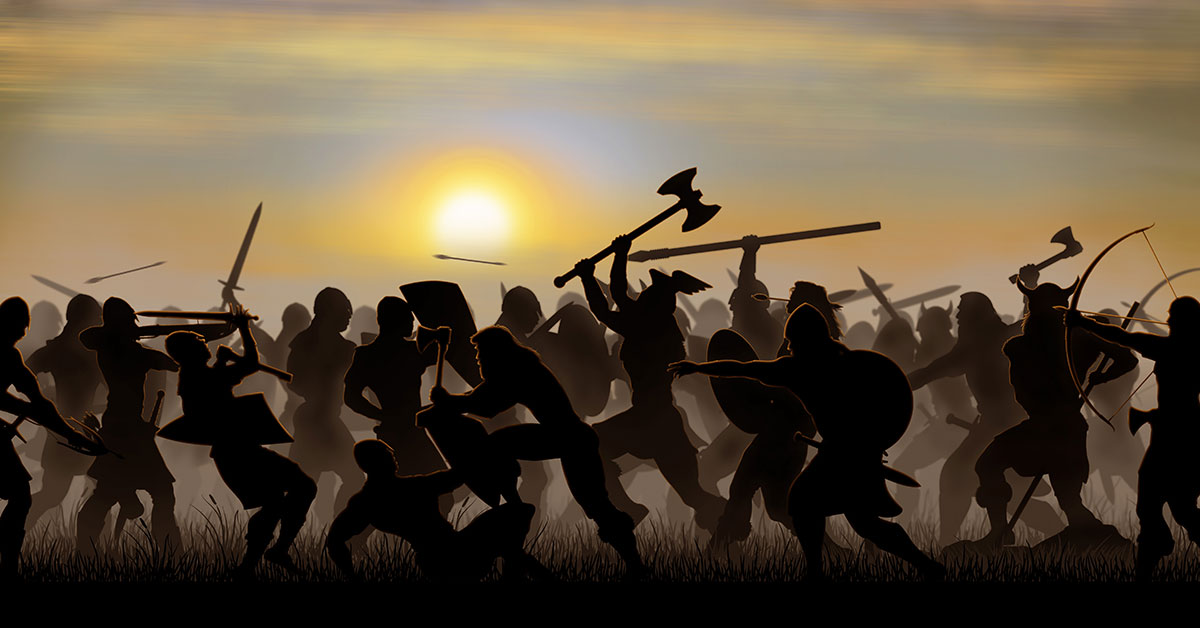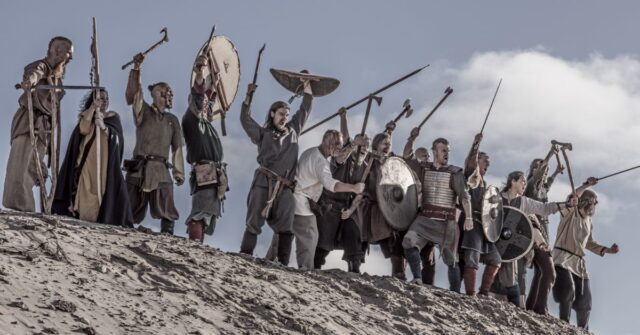Introduction
The Vikings, hailing from Scandinavia, were known for their seafaring and raiding prowess during the Viking Age (roughly 793-1066 AD). A significant part of their fearsome reputation can be attributed to the wide range of weapons they used in battle.
In this article, we will explore the various types of weapons the Vikings wielded, offering insights into their design, construction, and tactical use in warfare.
Brief Overview of Viking Warfare
Viking warfare was characterized by its brutal efficiency and adaptability. These skilled warriors relied on a combination of melee and ranged weapons, as well as naval capabilities, to achieve their objectives.
From raiding coastal settlements to engaging in full-scale battles, the Vikings were a formidable force, and their weapons played a critical role in their success.
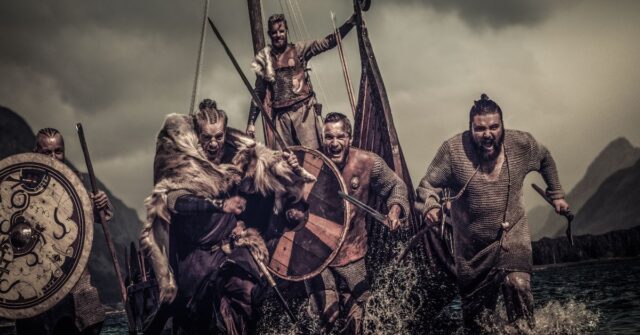

Importance of Understanding Viking Weapons
By examining the weapons the Vikings used, we gain a deeper understanding of their society, culture, and military tactics. This knowledge allows us to better appreciate the ingenuity and craftsmanship of these ancient warriors and provides a window into their lives and accomplishments.
Melee Weapons
Melee weapons were the cornerstone of the Viking warrior’s arsenal. These close-combat weapons, which included swords, axes, spears, and daggers, were crucial to their success in battle.
Skilled in the use of these weapons, Viking warriors were known for their brutal efficiency and adaptability.
Swords were symbols of power and prestige, while axes were versatile tools that could be used for both combat and daily tasks. Spears allowed for greater reach in both individual and formation combat, while daggers and knives served various practical and combat purposes.
By mastering the use of these melee weapons, Viking warriors were able to dominate their enemies and build a fearsome reputation.
Viking Swords
The sword was a highly valued and prestigious weapon among the Vikings, often reserved for wealthy warriors and chieftains. Swords were symbols of status and power, and their owners took great pride in their possession.
Viking swords typically featured a double-edged, straight blade, and a single-handed hilt.
The most famous type of Viking sword is the “Ulfberht,” which was made using higher-quality steel called crucible steel. These swords were both sharp and durable, making them highly sought after by Viking warriors.


Materials and Construction
Viking swords were primarily made of iron, with steel edges to ensure sharpness. The blades were often inlaid with patterns and inscriptions, adding to their visual appeal and value.
Hilts (the handles) were made from a variety of materials, including wood, bone, and antler, and were often adorned with ornate decorations, such as silver or bronze fittings.
Sword Symbolism in Viking culture
Swords were symbolic in Viking culture, often passed down through generations as family heirlooms. Some swords even had names, further emphasizing their significance.
When a Viking warrior died, it was not uncommon for his sword to be buried with him, as it was believed that the weapon would accompany its owner into the afterlife.
Viking Axes
The axe was a popular and versatile weapon among the Vikings, used both as a tool and a weapon. Its simplicity and effectiveness made it a staple in the Viking arsenal.
There were various types of Viking axes, each designed for specific uses.
The most common was the bearded axe, which featured a long, curved cutting edge that extended below the butt of the weapon. This design allowed for a better grip and more control when used in combat.
Additionally, the broadaxe and the long-axe were specialized axes designed for specific battlefield roles, such as breaking through enemy lines or reaching mounted opponents.
Materials and Construction
Viking axes were typically made from iron, with steel edges for increased sharpness and durability. Handles were often crafted from wood, such as ash or oak, and varied in length depending on the intended use of the axe.
Axes as Tools and Weapons
The versatility of the axe made it an essential item for the Vikings, who used it not only as a weapon but also as a tool for woodworking and other everyday tasks.
This multi-functionality allowed Viking warriors to carry fewer items, reducing their overall burden and increasing mobility.
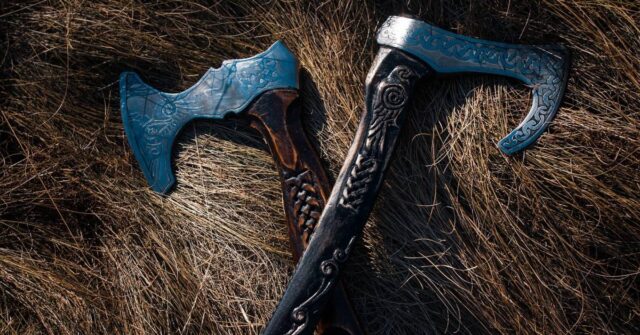

Spears
The spear was a common weapon among the Viking warriors, valued for its reach and adaptability. It was often used when in formation and during individual combat, making it an essential part of the Viking arsenal.
Viking spears typically featured a long wooden shaft and a sharp, iron, or steel spearhead. There were several types of spearheads, such as leaf-shaped, winged, and barbed, each with its unique advantages in combat.
Materials and Construction
The shafts of Viking spears were typically made of ash, a strong and flexible wood. Spearheads were made of iron or steel, with steel being preferred for its sharpness and durability.
Some spearheads were also adorned with intricate patterns or inlaid with precious metals for added prestige.
Spears in Formation and Individual Combat
In formation, Viking warriors would use their spears to create a formidable shield wall, with the spearheads protruding outwards to deter enemy advances.
In individual combat, the spear allowed for greater reach and versatility, enabling warriors to keep their opponents at a distance while striking with precision and power.
Daggers and Knives
Daggers and knives were essential tools and weapons for the Vikings, used in a variety of contexts from everyday utility tasks to close-quarters combat.
The most common type of Viking dagger was the seax, a single-edged blade with a straight or slightly curved design. Other types of knives included smaller utility knives and specialized fighting knives, such as the Hedeby knife.
Materials and Construction
Viking daggers and knives were typically made from iron, with steel edges for sharpness and durability. Handles were often crafted from wood, bone, or antler, and sometimes featured ornate decorations or inlays.
Utility and Ceremonial Uses
In addition to their use in combat, daggers and knives served many practical purposes, such as cutting rope, preparing food, and crafting. They were also used in ceremonies and rituals, making them an integral part of Viking daily life.
Ranged Weapons
Ranged weapons, such as bows and arrows, slings, and throwing weapons, provided the Vikings with a tactical advantage on the battlefield. These weapons allowed them to engage enemies from a distance, whittling down their numbers and weakening their defenses before closing in for melee combat.
Bows and arrows were particularly valued for their accuracy and range while throwing axes and javelins offered a powerful and devastating alternative. By employing ranged weapons effectively, Viking warriors could control the flow of battle and create opportunities for decisive victories.
Bows and arrows
Bows and arrows were an essential part of the Viking ranged arsenal, allowing warriors to engage enemies from a distance and with great accuracy.
The most common type of Viking bow was the longbow, which was made from a single piece of wood, such as yew or elm. The longbow provided excellent range and power, making it a formidable weapon in the hands of a skilled archer.
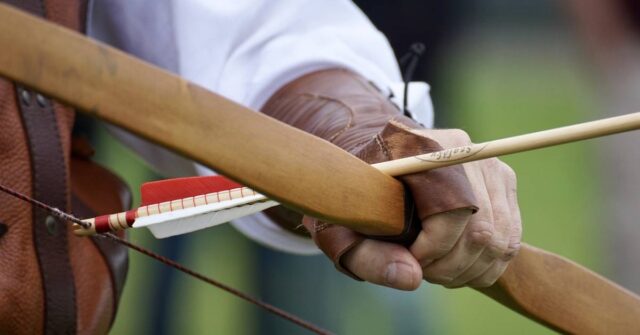

Arrowhead Materials and Designs
Viking arrowheads were typically made of iron or steel, with a variety of designs suited for different purposes.
Some arrowheads were broad and flat, designed for maximum impact against unarmored targets, while others were narrower and more streamlined for piercing armor.
Quivers and Archery Equipment
Viking quivers were often made from leather or fabric, designed to hold a supply of arrows for rapid access during combat. Archers also used bracers to protect their forearms from the bowstring and finger tabs or gloves to improve grip and accuracy.
Slings and Throwing Weapons
In addition to bows and arrows, the Vikings also employed slings and throwing weapons for ranged combat.
Among the throwing weapons used by the Vikings were the throwing axe, also known as the Francisca, and the throwing spear, or javelin. These weapons were designed for accuracy and penetration, making them effective at disrupting enemy formations and taking out key targets.
Materials and Construction
Throwing weapons were typically made of iron or steel, with designs optimized for aerodynamics and balance. Wooden handles or shafts were used to provide grip and control during the throw.
Tactics and Effectiveness
Viking warriors would often use slings and throwing weapons to harass and weaken enemy formations before closing in for melee combat. These ranged attacks could create openings in the enemy’s defenses, making it easier for the Viking warriors to gain the upper hand in battle.
Defensive Equipment
Defensive equipment, including shields and armor, played a crucial role in protecting Viking warriors from harm during battle.
Shields were an essential part of Viking defensive tactics, forming the basis of the renowned shield wall formation. Made from wood and reinforced with leather or rawhide, these round shields offered reliable protection against enemy attacks.
Armor, while not as widespread due to its cost and weight, provided additional protection for those who could afford it. Chainmail hauberks were the most common type of armor, offering flexibility and protection against cutting and stabbing attacks.
By utilizing defensive equipment effectively, Viking warriors could withstand enemy assaults and maintain their fighting prowess.
Viking Shields
Shields were an essential part of the Viking defensive arsenal, providing protection against enemy attacks and forming the backbone of their famous shield wall tactics.
The most common type of Viking shield was the round shield, which featured a central boss and a wooden construction reinforced with leather or rawhide. Other shield types, such as kite shields or bucklers, were less common but still played a role in Viking warfare.
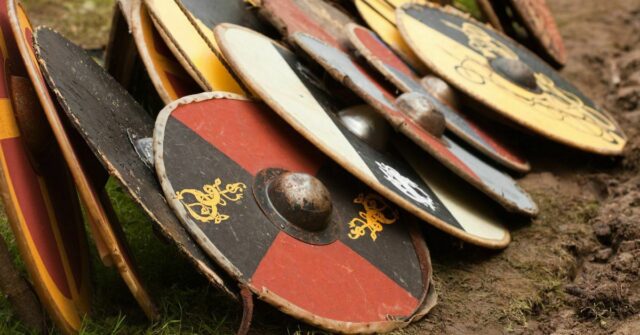

Materials and Construction
Viking shields were primarily made of wood, often from planks of linden, oak, or ash. The shields were then covered with leather or rawhide for added durability and protection.
The central boss, typically made of iron or bronze, provided additional structural support and served as a handguard for the shield bearer.
Shield Wall Tactics
In battle, Viking warriors would use their shields to form a tight, interlocking formation known as the shield wall.
This defensive tactic allowed the Vikings to protect themselves from enemy attacks while maintaining a solid front to advance or hold their ground.
The shield wall was a key component of Viking battle tactics and contributed to their effectiveness in combat.
Viking Armor
Armor was not as widespread among Viking warriors as one might assume. Due to the cost and weight of armor, only wealthier warriors could afford to wear it. However, those who did wear armor benefited from the increased protection it provided.
The most common type of Viking armor was the chainmail hauberk, a shirt made of interlocking metal rings that provided flexible protection against cutting and stabbing attacks.
Lamellar armor, made of small, overlapping plates, and scale armor were less common but still used by some Viking warriors.
Materials and Construction
Viking armor was typically made of iron or steel, with chainmail being the most popular choice due to its flexibility and relative ease of production. Leather and padded armor were also used, particularly by those who could not afford metal armor.
Protection vs. Mobility
While armor provided valuable protection in combat, it also came with the cost of reduced mobility.
Viking warriors had to balance the need for protection with the ability to move quickly and efficiently on the battlefield, leading to a variety of armor types and styles.
Naval Warfare
Naval warfare was central to the Viking way of life, with their iconic longships enabling them to swiftly traverse the seas and conduct devastating coastal raids. These sleek, shallow-draft vessels were expertly crafted, combining speed, maneuverability, and versatility.
Longships allowed the Vikings to transport troops and supplies, engage in surprise attacks, and establish a dominant presence on the seas.
During naval engagements, Viking warriors relied on their melee weapons and boarding tactics to overwhelm enemy crews, using ranged weapons to weaken their opponents before closing in for close-quarters combat.
The mastery of naval warfare was instrumental to the expansion and success of the Viking people.
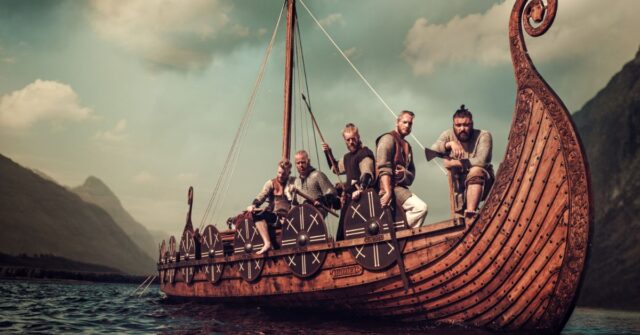

Viking Longships
Viking longships were the key to their naval dominance, enabling them to swiftly traverse the seas and conduct devastating coastal raids. Longships were characterized by their sleek, shallow-draft design, which allowed for speed and maneuverability.
They were primarily built using the clinker method, with overlapping wooden planks creating a strong and flexible hull. The ships were powered by both oars and a single, square sail, enabling them to navigate effectively in various wind conditions.
Role of Longships in Viking Warfare
Longships allowed the Vikings to quickly transport troops and supplies, conduct surprise raids, and establish a strong presence on the seas. These ships played a crucial role in the expansion and success of the Viking people throughout the Viking Age.
Naval Weaponry and Tactics
Naval combat in the Viking Age focused primarily on boarding actions and close-quarters fighting.
Boarding Actions and Close Combat
During naval engagements, Viking warriors would attempt to board enemy ships and engage in fierce hand-to-hand combat.
The Vikings relied on their melee weapons, such as swords, axes, and spears, as well as their shields, to gain the upper hand in these close-quarters battles.
Superior numbers, surprise attacks, and the fearsome reputation of the Viking warriors often played a key role in their success at sea.
Use of Ranged Weapons at Sea
While the primary focus of Viking naval warfare was on boarding actions and close combat, ranged weapons such as bows and arrows, throwing axes, and javelins were also employed to harass and weaken enemy crews.
These ranged attacks could create chaos and confusion among the enemy, making it easier for the Vikings to board and capture their ships.
Siege Weapons
Though not as well-known for their siege warfare, the Vikings did employ various siege tactics and tools when necessary.
Scaling ladders, grappling hooks, and battering rams were used to breach enemy fortifications, while siege towers and other tools were employed less frequently.
Viking siege tactics often focused on creating confusion and disarray among defenders, using fire and smoke to their advantage.
While siege weapons played a lesser role in their overall military strategy, the Vikings’ adaptability and ingenuity allowed them to successfully engage in siege warfare when circumstances required.
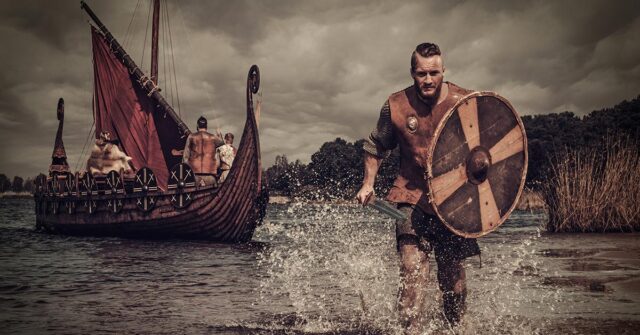

Viking Siege Tactics
Though not as well-known for their siege warfare as other aspects of their military prowess, the Vikings did employ a variety of siege tactics and tools when necessary.
Scaling Ladders and Grappling Hooks
To scale enemy fortifications, the Vikings would use scaling ladders and grappling hooks. These simple tools allowed them to quickly and efficiently breach walls and gain access to defended positions.
Battering Rams
Battering rams were another siege tool used by the Vikings, designed to break down gates and doors. These devices typically consisted of a large, heavy log suspended from a frame, which was then swung repeatedly against the target to break it down.
Siege Towers and Other Tools
Siege towers, although not as commonly used by the Vikings, were sometimes employed to gain access to elevated defensive positions.
Other tools, such as fire and smoke, were also used to create confusion and disarray among defenders, making it easier for the Vikings to breach their defenses.
Vikings and Siege Warfare
While the Vikings did use siege weapons and tactics, they were generally more focused on hit-and-run raids and open-field battles.
Reasons for Limited Use of Siege Weapons
The limited use of siege weapons can be attributed to several factors, including the Vikings’ preference for swift and mobile warfare, as well as the time and resources required to construct and transport siege equipment.
Adaptations to Local Environments
As the Vikings expanded their territories and encountered new challenges, they adapted their strategies and tactics to suit the local environment. This adaptability allowed them to successfully engage in various types of warfare, including sieges when necessary.
Conclusion
The Vikings employed a diverse array of weapons and equipment, ranging from the iconic sword and axe to more specialized tools such as throwing weapons and naval armaments. This variety allowed them to adapt to different combat scenarios and strike fear into the hearts of their enemies.
Weapons played a central role in Viking culture, serving not only as tools of war but also as symbols of status and power. By understanding the weapons the Vikings used and the tactics they employed, we gain a deeper appreciation for their society and the impact they had on the world during the Viking Age.

